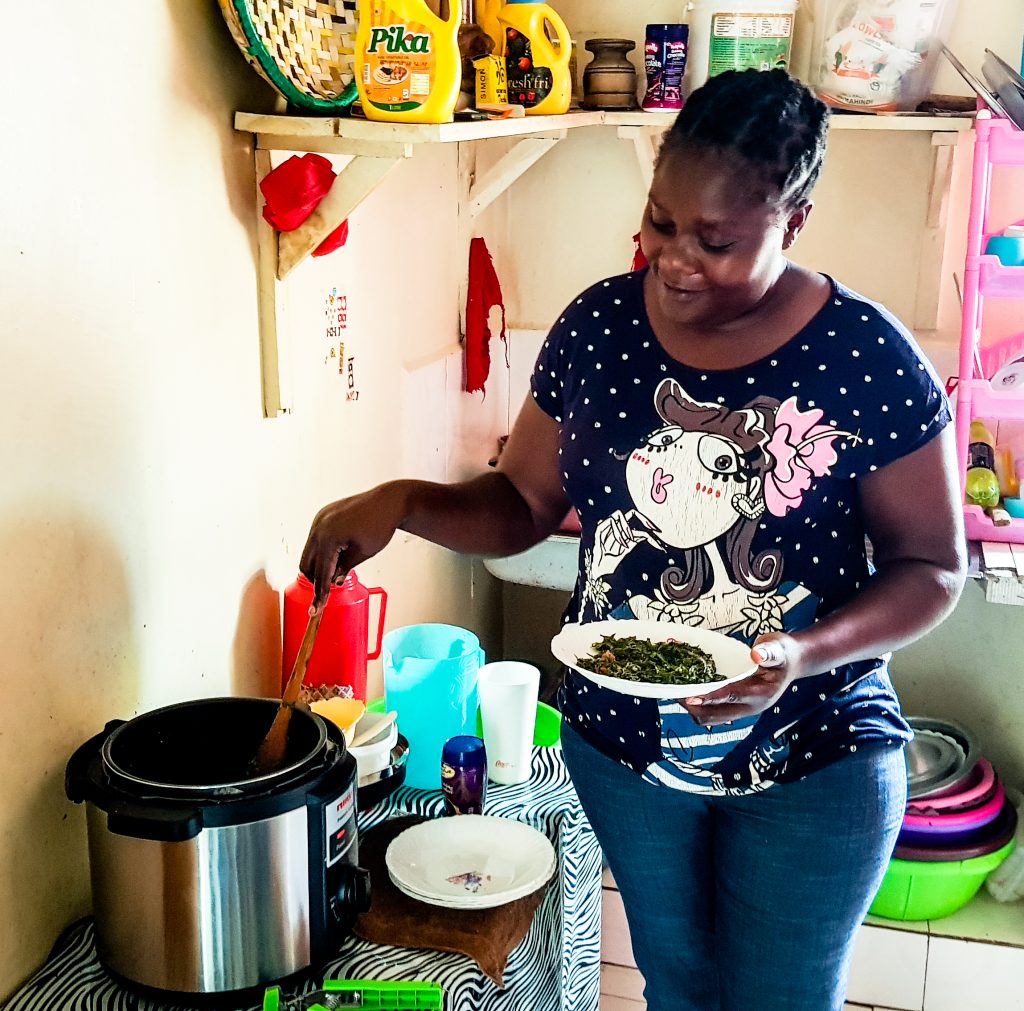- Date
- 6th April 2020
- Categories
By Jacob Fodio Todd (University of Sussex), Jon Leary (Loughborough University), Mourine Cheruiyot (ACTS), Jessie Press-Williams (Burn Manufacturing).
In November 2019, a team from MECS spent the day with Burn Manufacturing visiting participants in a pilot scheme to test user preferences and collect feedback on electric pressure cooking.
Our first stop, twenty minutes north of Nairobi, is to eat a delicious meal of ugali and sukuma wiki, cooked on an electric pressure cooker (EPC). We are visiting participants in a pilot scheme in and around Nairobi to test user preferences, collect feedback on EPCs and test how the appliance fits in Kenyan kitchen routines. Both from a financial and culinary perspective, so far, so good. Lucy, our host, is able to cook most of her dishes using the new appliance and make regular savings.

Lucy fuel stacks, typically spending around 1600KSh per month on LPG, and about 50KSh per day on kerosene. She still fuel stacks, but electricity has made inroads. Since the trial started, her electricity bill increased by 100KSh a month although her kerosene use fell, by 20KSh per day. Lucy tells us that kerosene can be bought in smaller quantities, which makes financial planning easier on a limited budget. Interestingly, it is LPG that has been displaced. Now, in the second month of the trial Lucy’s LPG cylinder has not had a refill.
Next, we visit Emily on the outskirts of Thika, an industrial town north of Nairobi. Emily welcomes us into her home and sets about making us pilau njeri. This rice dish is the pragmatic cousin of conventional pilau, that substitutes pilau masala for everyday seasoning and a medley of whatever vegetables are available. Emily uses the EPC regularly but is more selective with the dishes she chooses to cook in it, typically cooking staples, heavy foods and one pot meals, such as the one we are being treated to. Emily sets about making her rice dish: frying onions, carrots and potatoes in the device before adding rice, water and seasoning, fixing the lid and setting a 7-minute timer.
About thirty minutes after we arrive, and shortly after Emily has set the rice to cook, we notice two things in quick succession. Firstly, that a waft of steam has escaped from the safety valve on the EPC, indicating that it was approaching pressurisation. Secondly, that the dial on the EPC was blank. There had been a power cut. This was fairly rare Emily tells us before adding, in jest, that obviously Kenya Power, the national utility company, ‘were waiting for guests to arrive’.
In the end, the power cut wasn’t the problem, our impatience was. After waiting about 15 minutes we began to say our goodbyes, having given up on power returning. Typically, as we opened the door, it returned. Emily, out of faith or curiosity, opened the lid, to reveal perfectly cooked rice despite the EPC having been switched off for a while. Evidently, it had just managed to pressurise before the power cut. This hiccup demonstrates one of the most important characteristics of the EPC in weak-grid contexts: that insulation can mitigate blackouts.
An EPC uses full power getting food up to pressure and from that point, it only draws power occasionally to maintain pressure. The insulation greatly reduces the rate of heat loss from the pot, so only small amounts of power are needed to keep it at a constant temperature. Once food in the pot is up to temperature, the retained heat continues to cook the food, without requiring additional energy input. It usually takes around 15 mins for the EPC to depressurise naturally (i.e. for the temperature inside to drop from around 120C back to boiling at 100C). For short cooking dishes, like our pilau njeri, the food can therefore cook completely within the time it takes for the heat to escape through the EPC’s insulation. That is why we could retake our seats and tuck into a plateful of fantastically seasoned rice.
Emily and her family love food cooked using the EPC, and are particularly thankful of the absence of the smell of paraffin. The family meanwhile have become more conscious of electricity being used. This has led to small changes in habit: switching off lights, unplugging devices not being used, and of course using an EPC.
Later, we visit Burn’s factory in Ruiru. Here they manufacture one of Kenya’s best-selling improved cookstoves (ICS), the Jikokoa (the stove that saves). It is an impressive place, with a whirr of finely tuned equipment, carefully designed manufacturing processes and a well-trained workforce. In an industry dominated by ‘jua kali’ informal manufacturers and Chinese imports, it is easy to see why they emphasise this factory as “the only modern cookstove factory in Sub-Saharan Africa”. Burn invest heavily into ongoing research and development, and their EPC is one of the most exciting products in the pipeline. This is what we are here to see.

Jessie Press-Williams, who leads Burn’s EPC product development, explains to us that EPCs – for the Kenyan market – are a ‘no-brainer’. Her team are undertaking rigorous laboratory testing on safety, robustness and energy-efficiency, and an extensive field-testing programme designed to gather detailed user feedback. As one of the winners of the first round of the MECS-LEIA Challenge fund, they are making fast progress. The global market for EPCs is currently dominated by Chinese manufacturers producing for the Asian, European and North American markets. However, with their success in bringing the Jikokoa and its siblings to the mass markets across the African continent, it is exciting to see how Burn could transform the EPC market with a product designed for and produced by Africans.